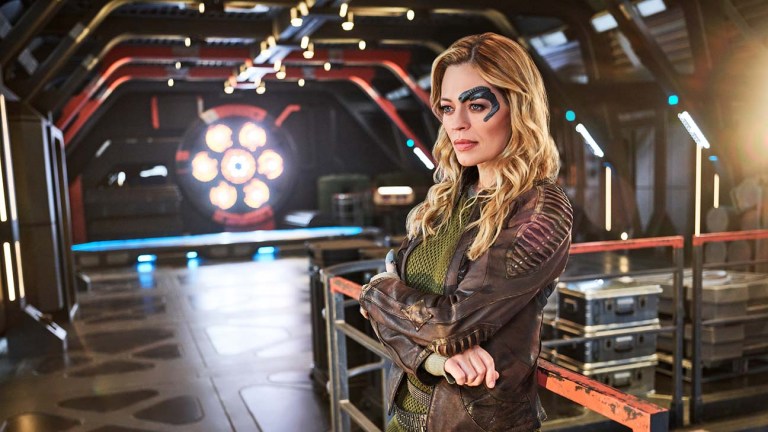Why Picard’s Decision to Make Seven of Nine Queer is So Important
The Star Trek: Picard finale casually confirmed Seven of Nine as a queer character, something many Star Trek fans have been hoping for for a while.

This Star Trek: Picard review contains spoilers for the finale.
The return of original Star Trek: Voyager character Seven of Nine has been one of the most unexpected joys of Star Trek: Picard Season 1. Though Seven and Picard had never previously met in mainstream Trek continuity, the two’s shared experience of assimilation at the hands of the Borg ties them together in intriguing and emotional ways, and Picard deftly manages to display the ways in which she has become darker, more complicated, and more fully human in the years since her original return to Earth at the conclusion of Voyager.
Jeri Ryan only appears in five episodes of Picard – one of which is a minute-long surprise reveal in the fourth episode’s closing moments – but Seven’s arc over the course of the series’ first season is a fascinating one. This is a woman who has clearly spent the intervening years since her last Trek appearance figuring out precisely who she is. She’s dedicated her life to dispensing justice to reprobates on the far reaches of the galaxy as part of the vigilante group the Fenris Rangers, and enters the world of Picard on a quest to avenge the death of Icheb, a former Borg drone who became like a son to her during her time on Voyager. Over the course of this series’ first season, we watch Seven face down her greatest fear (reconnecting to the Borg collective), fight to save her friends, and, presumably, join the crew of the La Sirena for Season 2.
And we also got confirmation (or at least a strong implication) that Seven is, in fact, bisexual.
The concluding moments of the Picard season finale definitely seem to indicate that Seven is canonically queer, showing her holding hands with Raffi in what seems to be a very romantic way.
There are, of course, some lingering questions here, given that Seven and Raffi were rarely shown even having conversations this season, let alone flirting. How did this romance blossom? And isn’t that something we, as viewers deserved to see onscreen?
(The answer to that question is yes, by the way, even if the pair does turn out to be a major part of Picard’s second season. We deserve flashbacks, is what I’m saying.)
Nevertheless, it’s hard to understate the importance of the decision to seemingly make such an iconic Star Trek character like Seven of Nine queer. This is a franchise that has often struggled with living up to the inclusive and diverse future it espouses onscreen in deed as well as in word.
The first openly gay series regulars weren’t introduced to the Trek universe until 2017 (yes, you read that correctly) in the form of Star Trek: Discovery’s Paul Stamets and Hugh Culbert. And while J.J. Abrams film Star Trek: Beyond made Hikaru Sulu explicitly queer, that’s technically a character that only exists in an alternate universe, not on the “Prime” timeline. LGBTQ+ Trek fans have often claimed a special kinship with Seven of Nine, feeling a particular connection to her journey to re-engage her humanity and fit in with world that doesn’t accept her for who she is. (And many fans are still actively writing Voyager fanfiction about Seven and Captain Janeway.)
So, yeah, officially making Seven of Nine—a legacy character who remains one of the most popular figures in the entire Trek franchise—bisexual is definitely a big deal, and something that should be celebrated as an important step forward. (Gene Roddenberry, I think, would be proud.)
Furthermore, this twist shouldn’t necessarily come as that big of a surprise to viewers. As someone who was raised in the Borg collective from the time she was six, it makes sense that Seven wouldn’t necessarily have terribly rigid views about things like gender and sexuality. In fact, back when the character was first introduced on Voyager, there was a not insignificant amount of fan speculation that Seven would turn out to be gay, but for various reasons that development never panned out. It was television in the 1990s, and many television executives apparently balked at the idea of including an LGBT character on something they viewed as a “family show.”
Instead, Seven was eventually romantically paired off with Chakotay, and the two were generally happy together. But Star Trek fans know how hard Seven had to work to reconnect with her humanity following her time as a Borg, so it certainly feels true to life that it might take her some time to figure out her precisely what her orientation might be, particularly once Chakotay was out of the picture. And any romantic or sexual relationship Seven may or may not have with Raffi would not negate or diminish Seven’s relationship with Chakotay. Both can exist as valid parts of Seven’s story.
In Picard episode “Stardust City Rag,” Seven helps Picard, Raffi and Rios locate Bruce Maddox on the casino planet of Freecloud. She, as it turns out, has a history with Bjayzl, the crime lord that’s taken him prisoner, and is known for her black market dealings in harvested Borg parts. She’s eager to dole out some serious revenge, given that Bjayzl is responsible for Icheb’s death. But there’s also a very personal sense of betrayal between the two that permeates every scene they share.
While the show doesn’t explicitly spell out the fact that Seven and Bjayzl had a relationship prior to Icheb’s death, it’s nevertheless strongly hinted that the two were intimate at one point. The two were close enough that Bjayzl knows Seven’s “real” (human) name, and that Seven trusted her enough to tell her about Icheb – and how much he meant to her – in the first place. It’s why Bjayzl’s betrayal hurts so much, beyond the mere fact of Icheb’s death. It’s because Seven, who has fought so hard to reclaim her humanity, put her fragile faith in someone who ultimately didn’t deserve it, and the only way she knows how to process the loss of that is to kill her.
How, precisely, this all translates into a burgeoning romance with Raffi – who wasn’t, by the way, even part of that initial trip to Stardust City – is anyone’s guess. While Picard has made a point of hinting at Seven’s sexuality all season, that hasn’t really been the case with Jean-Luc’s later-in-life BFF. We know that Raffi is a recovering addict with an ex-husband and an estranged son, but any hint that her sexuality be anything other than straight is limited to that revelation of an “old (female) friend” who secured Picard diplomatic access to the Borg artifact.
Truth be told, there’s something deeply appealing in the prospect of these two damaged, lonely people finding comfort and affection, or even love, with one another. Raffi and Seven may be an odd pairing on paper—they’ve lived very different lives—but they’re also women who live with a lot of regrets and who are, every day, attempting to choose their better angels over their inner demons. Here’s hoping we’ll get to see them figuring out the next stage of their journey – together – in Season 2.
